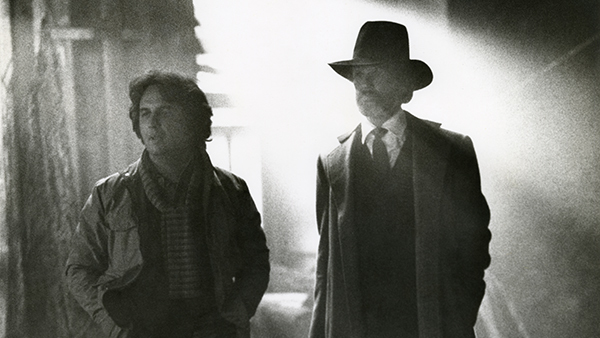A Tribute to Michael Cimino

On July 2, 2016, director Michael Cimino passed away. I find the fact that he left us so close to the Fourth of July, this most national of holidays, deeply moving, because no other contemporary filmmaker had consistently mined such a wealth of stories and haunting visuals from America itself: its breathtaking landscapes, myriad cultures, and tumultuous history. (And no, I’m not referring to this interest as his “theme,” because Michael would’ve chastised me for using such a highfalutin concept in relation to his movies.)
I once asked Michael about that unwavering focus on this country, and his answer was simple: he loved it and felt there was no richer source for stories, whether they sprang from conflicts of the past or struggles in the present.
His 1974 directorial debut, Thunderbolt and Lightfoot, is packed with tense heists and hilarious buddy camaraderie, but it’s also suffused with melancholy over the vanishing Big Sky landscapes and towns so beautifully captured within it. His best picture Academy Award winner, The Deer Hunter (1978), with its friends and lovers torn asunder by the Vietnam War, locates its heartland in a blue-collar Pennsylvania steel town so richly presented one can almost catch whiffs of the smoke and smelting ore. Year of the Dragon (1985) isn’t just a top-notch, gritty policier, but a multifaceted look at Chinese immigrant experience in New York.
And the backbone of these diverse narratives—the cinematic “truth” of them, if you will—is often provided by Michael’s fastidious attention to detail, a trait that links all of his works. For example, Year of the Dragon’s Chinatown sets are so spatially and texturally credible that even the New York City–born Stanley Kubrick—no stranger to perfectionism himself—couldn’t believe after seeing the film that the neighborhood had been built from the ground up on studio lots in Wilmington, North Carolina.
But it’s the western Heaven’s Gate (1980) that will forever be Michael’s crowning achievement. Every wooden surface, blade of grass, cloud in the sky, creak of leather, and mote of dust simply transports you to 1890s Wyoming. In this age in which green-screened, computer-generated environments seem commonplace in movies, the tactile, lived-in quality of Michael’s town of Sweetwater is a “special effect” of the greatest kind, one that doesn’t just lend credence to the tragedy in his historical story line, but also imparts life to the characters within it.
That life also springs forth from Michael’s willingness to follow characters beyond core narrative concerns. He once told me that seeing a movie is akin to watching an onstage performance framed by a proscenium. One only sees the primary action framed within that plane of space. Michael was always more interested in looking around the proscenium, having a peek at the bustle and activity in the wings. For him, those moments outside of the main focal point were what made movies tick, made them sing with life.
In his 2012 interview on our disc, which also included producer Joann Carelli, Michael expanded on his thoughts about smashing through the proscenium to bring the vitality of three-dimensional space—and all that occurs in it—to a two-dimensional screen.
Heaven’s Gate has one of cinema’s greatest proscenium busters: the roller-skating scene. Many might consider it a narrative speed bump, an expendable sequence that’s not germane to plot mechanics, but the joys, aspirations, and kinship of the film’s hardscrabble immigrant community would not be as palpable—nor the ending half as heart-rending—without this masterful moment.
To pull that scene off, the cast had to learn how to effortlessly circle a rink on period-accurate roller skates. The practice sessions were long and grueling. The actors also had to take daily riding lessons to look credible on horseback. Rifle lessons were a requirement. The women playing prostitutes lived in a bordello to experience its day-to-day workings. The actors lived, breathed, and slept their characters.
For Michael, who never went to film school, this was the only way to make a movie; he knew no other way to replicate his vision. His production methods might have been atypical, but as every gorgeous frame of Heaven’s Gate shows, he had an innate understanding of the power that motion pictures could have. And while I’m certainly not suggesting that there are no more directors who share his exacting standards, I do believe that with Michael’s passing we’ve lost someone devoted to bringing movies to life as life, both in front of and behind the camera, and I don’t think we’ll see the likes of his approach to filmmaking on this scale anytime soon. I’m reminded of the tagline for Heaven’s Gate: “What one loves about life are the things that fade.”
Some months after our release of Heaven’s Gate, I received a phone call from Michael. He told me how gratifying the entire experience of remastering the film had been, how invigorating it was to work with everyone here, and how the collaboration had in many waysrepresented an ideal production process for him. I couldn’t have been more thrilled to hear his words, not only because we’d been able to match his standards but also because he was finally, rightfully able to find joy in his film once more. So I stuttered out a reply. “Wow, Michael, that really means a lot to me. I don’t know what to say.”
“What about ‘Thank you,’ Curtis? Sometimes ‘Thank you’ is enough.”
Thank you, Michael. You were one of a kind.




